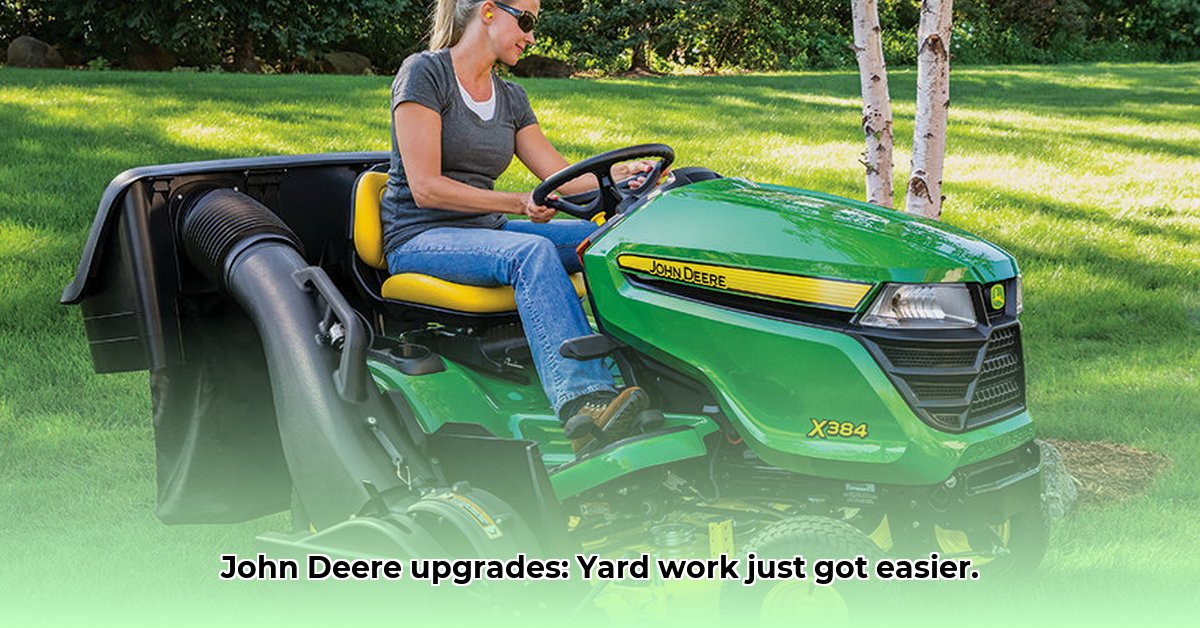
Ready to transform your lawn care routine? John Deere lawn tractor attachments can make yard work easier, more efficient, and even more environmentally friendly. This guide will walk you through selecting the right attachments, using them safely, and planning for long-term sustainability. For more information on available attachments, check out this helpful resource: John Deere Attachments.
Choosing the Right John Deere Attachments
Selecting the ideal John Deere attachments depends on your specific needs, budget, and sustainability goals. Are you a homeowner with a small lawn or a landscaper managing large commercial properties? This decision significantly impacts your attachment choices.
For Homeowners: Prioritize ease of use and functionality. Consider attachments like a mulching kit for healthier grass, a snow thrower for winter, or a leaf collection system for fall cleanup. Simplicity often reigns supreme for residential needs.
For Commercial Users: Focus on durability and efficiency. Heavy-duty attachments designed for frequent, intensive use are essential. A powerful flail mower, for instance, can significantly increase efficiency on large properties compared to a smaller rotary mower. Return on investment is a key factor here.
Regardless of your situation, consulting the John Deere catalog or speaking with a dealer is crucial for personalized recommendations. They can guide you towards the perfect attachments based on your tractor model and individual needs.
Mastering Your John Deere Attachments: Safe and Effective Use
Safe and effective attachment use is paramount. Always consult your owner's manual—it's your primary resource for safe operation. Here are some essential guidelines:
Prepare Your Work Area: Before starting, clear the area of any obstacles (rocks, toys, branches) that could be caught or thrown by the attachment. Safety begins with preparation.
Secure Attachments Properly: Double-check that the attachment is firmly secured to your tractor. Loose attachments are dangerous. Ensure everything is locked and stable before starting the engine. If uncertain, consult the manual or your dealer.
Prioritize Safety Gear: Always wear safety glasses, sturdy shoes, and hearing protection (especially for noisy attachments). Never allow children or pets near running equipment. Safety precautions are non-negotiable.
Maintain Safe Speeds: Avoid rushing, particularly with heavier attachments. Excessive speed can lead to loss of control and lawn damage. A slower pace ensures both safety and a well-maintained lawn.
Regular Inspections: Before and after each use, inspect your attachments for wear and tear. Early problem detection prevents costly repairs. Preventative maintenance saves significant time and money in the long run.
Mulching vs. Bagging: An Eco-Friendly Choice
Mulching and bagging grass clippings offer distinct environmental impacts.
| Method | Pros | Cons |
|---|---|---|
| Mulching | Returns nutrients to soil; reduces water & fertilizer needs; healthier lawn; saves time and effort | Can be messy with long grass; unsuitable for all grass types |
| Bagging | Clean results; ideal for leaf removal; no messy clippings | Creates waste needing disposal; more time-consuming; less beneficial for lawn |
Mulching generally provides a lower environmental impact by returning nutrients to the soil, reducing fertilizer use, and conserving water. Bagging, while convenient, results in waste that needs disposal. Your choice depends on your priorities and lawn conditions.
Long-Term Planning and Maintenance
Investing in John Deere attachments is a long-term commitment. Proper maintenance is crucial to extend their lifespan and maximize your investment.
Regular Cleaning: Remove debris after each use to prevent rust and corrosion. Regular cleaning is a simple yet highly effective maintenance practice.
Lubrication: Follow the owner's manual for recommended lubrication schedules. Proper lubrication minimizes wear and tear.
Storage: Store attachments in a dry place to protect them from the elements. Proper storage is a critical aspect of longevity.
Responsible Disposal: Dispose of worn-out attachments responsibly through recycling programs to reduce landfill waste. Sustainability should extend even to disposal practices.
The Broader Picture: Sustainability in Lawn Care
While mulching is more environmentally friendly, remember that all power equipment has an environmental footprint. However, the efficiency gains from using attachments often outweigh the environmental cost compared to manual methods. Ongoing research continues to refine our understanding of lawn care's impact; stay updated on these developments.
How to Compare Lifecycle Environmental Impact
The environmental impact of lawn care extends beyond initial cost. Consider the entire lifecycle: manufacturing, use, and disposal.
Factors to Consider:
Manufacturing Processes: Sustainable materials and manufacturing methods reduce initial environmental impact.
Energy Consumption: Efficient attachments reduce fuel consumption and greenhouse gas emissions; mulching, for example, often uses less fuel than bagging.
Durability and Lifespan: A long-lasting attachment minimizes waste and replacements.
Maintenance: Assess the environmental impact of maintenance procedures.
Disposal: Consider the recyclability and responsible disposal options.
Choosing the Right Attachment: A Step-by-Step Guide
- Assess your needs: Define your lawn care tasks and lawn size.
- Research John Deere attachments: Explore model specifications and features.
- Compare energy efficiency: Prioritize low fuel consumption ratings.
- Consider durability & lifespan: Opt for high-quality, long-lasting attachments.
- Factor in maintenance: Choose easily maintained attachments.
- Check for recyclability: Consider the end-of-life disposal options.
- Make an informed decision: Balance initial cost with long-term benefits.
By combining the right John Deere attachments with responsible use and maintenance, you can significantly enhance the efficiency and sustainability of your lawn care, benefiting both your yard and the environment.